News
Tolga Tasdizen to Serve as a USTAR Faculty Member Within the SCI Institute
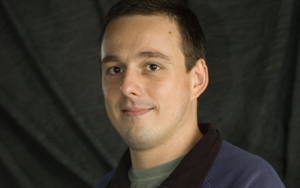 Dr. Tolga Tasdizen has joined the SCI faculty as an Assistant Professor of the Department of Electrical and Computer Engineering and will become the SCI Institute's second USTAR Faculty member, joining Dr. Guido Gerig. Prior to being appointed USTAR Faculty, Tolga was a Research Assistant Professor in the School of Computing at the University of Utah. Dr. Tasdizen received his Ph.D. in Engineering from Brown University and is an expert in image processing, creating state-of-the-art research applied to biomedical and biological applications such as reconstructing neural circuit diagrams from large numbers of very high resolution microscopy images. His research interests include image analysis, computer vision and pattern recognition. The Utah Science and Technology Research Initiative (USTAR) is a state-funded, long-term effort to strengthen Utah's "knowledge economy".
Dr. Tolga Tasdizen has joined the SCI faculty as an Assistant Professor of the Department of Electrical and Computer Engineering and will become the SCI Institute's second USTAR Faculty member, joining Dr. Guido Gerig. Prior to being appointed USTAR Faculty, Tolga was a Research Assistant Professor in the School of Computing at the University of Utah. Dr. Tasdizen received his Ph.D. in Engineering from Brown University and is an expert in image processing, creating state-of-the-art research applied to biomedical and biological applications such as reconstructing neural circuit diagrams from large numbers of very high resolution microscopy images. His research interests include image analysis, computer vision and pattern recognition. The Utah Science and Technology Research Initiative (USTAR) is a state-funded, long-term effort to strengthen Utah's "knowledge economy".
Greg Jones Voted Top 100 vSpring Capital Venture Entrepreneur for 2008
 Congratulations go out to our new Associate Director Greg Jones who was recently designated a v|100 - vSpring Top 100 Venture Entrepreneur. The v|100 designation is given to those individuals voted most likely to lead a successful business venture in Utah within the next few years. The v|100 is designed to help entrepreneurs and vSpring Capital establish and cultivate relationships among top CEO and CTO talent in the region. Members of this elite executive community are chosen through a peer-nominated and peer-selected process. Top members of the Utah business community were surveyed by a vSpring team to nominate the top 100 ventrue entrepreneurs in Utah. 2008 marks the fifth year of the v|100 Community. Greg was also selected as a v|100 member in 2005.
Congratulations go out to our new Associate Director Greg Jones who was recently designated a v|100 - vSpring Top 100 Venture Entrepreneur. The v|100 designation is given to those individuals voted most likely to lead a successful business venture in Utah within the next few years. The v|100 is designed to help entrepreneurs and vSpring Capital establish and cultivate relationships among top CEO and CTO talent in the region. Members of this elite executive community are chosen through a peer-nominated and peer-selected process. Top members of the Utah business community were surveyed by a vSpring team to nominate the top 100 ventrue entrepreneurs in Utah. 2008 marks the fifth year of the v|100 Community. Greg was also selected as a v|100 member in 2005.
Steve Corbató Named Director of Cyberinfrastructure Strategic Initiatives at the University of Utah
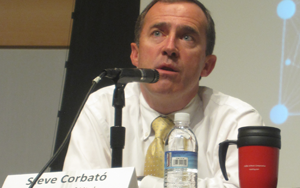 The Scientific Computing and Imaging Institute congratulates Dr. Steve Corbató on being named Director of Cyberinfrastructure Strategic Initiatives at the University of Utah. Dr. Corbató has served as the SCI Institute's Associate director since May of 2006. Steve will report directly to VP of Information Technology, Steve Hess and help the University with future cyberinfrastructure plans. While Steve will be moving to the INSCC Building, we'll definitely still see him on a regular basis as we'll work together on future computing initiatives. Steve is already working on multiple projects and ideas with SCI Institute and other University of Utah faculty.
The Scientific Computing and Imaging Institute congratulates Dr. Steve Corbató on being named Director of Cyberinfrastructure Strategic Initiatives at the University of Utah. Dr. Corbató has served as the SCI Institute's Associate director since May of 2006. Steve will report directly to VP of Information Technology, Steve Hess and help the University with future cyberinfrastructure plans. While Steve will be moving to the INSCC Building, we'll definitely still see him on a regular basis as we'll work together on future computing initiatives. Steve is already working on multiple projects and ideas with SCI Institute and other University of Utah faculty.
Center for Computational Earth Sciences at the SCI Institute
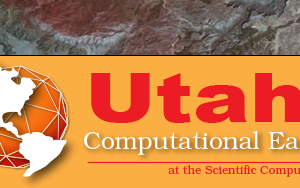 Ross Whitaker (PI), Chuck Hansen, Claudio Silva, Valerio Pascucci, and Greg Jones have been awarded funding to create the Center for Computational Earth Sciences at the SCI Institute.
Ross Whitaker (PI), Chuck Hansen, Claudio Silva, Valerio Pascucci, and Greg Jones have been awarded funding to create the Center for Computational Earth Sciences at the SCI Institute.
Visualizing Election Polls
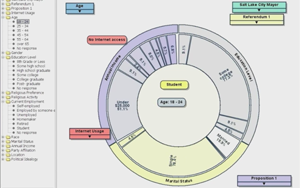 A New, Animated, Interactive Way to Analyze Opinion Data
A New, Animated, Interactive Way to Analyze Opinion DataMedia Contacts
Oct. 6, 2008 - Do you want to know the percentage of white women who support vice presidential candidate Sarah Palin? What about college-educated versus high school-educated white women? Or those who also hunt?
University of Utah computer scientists have written software they hope eventually will allow news reporters and citizens to easily, interactively and visually answer such questions when analyzing election results, political opinion polls or other surveys.
NVIDIA Recognizes University Of Utah as a CUDA Center Of Excellence
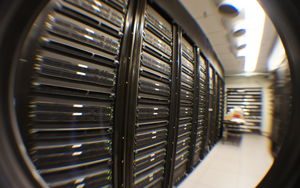 University of Utah Latest in a Growing List of Exceptional Schools Demonstrating Pioneering Work in Parallel Computing
University of Utah Latest in a Growing List of Exceptional Schools Demonstrating Pioneering Work in Parallel ComputingSanta Clara, CA & Salt Lake City, UT - July 31, 2008 - NVIDIA Corporation, the worldwide leader in visual computing technologies, and the University of Utah today announced that the university has been recognized as a CUDA Center of Excellence, a milestone that marks the beginning of a significant partnership between the two organizations.
Best Paper Awards Keep on Coming
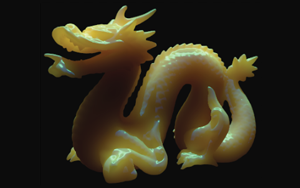 Daniel Kopta, who was part of the author team that received the Best Paper Award at SASP '08 for their paper: "TRaX: A Multi-Threaded Architecture for Real-Time Ray Tracing," Josef Spjut, Daniel Kopta, Spencer Kellis, Solomon Boulos, Erik Brunvand
Daniel Kopta, who was part of the author team that received the Best Paper Award at SASP '08 for their paper: "TRaX: A Multi-Threaded Architecture for Real-Time Ray Tracing," Josef Spjut, Daniel Kopta, Spencer Kellis, Solomon Boulos, Erik BrunvandDavid Brayford, received the Ken Brodlie best paper prize at the Theory and Practice of Computer Graphics 2008 Conference (TPCG08) for his paper "A Physical Model for the Polarized Scattering of Light."
Mike Kirby, Tobias Martin, and Elaine Cohen, best Paper Award at the ACM Solid and Physical Modeling International Conference (SPM) 2008 for "Volumetric Parameterization and Trivariate B-spline Fitting using Harmonic Functions" by Tobias Martin, Elaine Cohen, and Mike Kirby.
Hao Wang, Carlos Scheidegger, and Claudio Silva won the Best Paper Award at the IEEE International Conference on Shape Modeling and Applications (SMI), 2008 with "Optimal Bandwidth Selection for MLS Surfaces."
Remembering Gene Golub - Salt Lake City, Utah
Those attending the event in Salt Lake City were:
Nelson Beebe, Department of Mathematics, University of Utah
Adam Bargteil - Carnegie Mellon University
Martin Berzins, School of Computing and SCI Institute, University of Utah
Mary Anne Berzins, Human Resources, University of Utah
Elaine Cohen, School of Computing, University of Utah
Kate Coles, Department of English, University of Utah
Steve Corbato, Office of Information Technology, University of Utah
Chuck Hansen, School of Computing and SCI Institute, University of Utah
Chris Johnson, School of Computing and SCI Institute, University of Utah
Greg Jones, SCI Institute
Tom Lyche, Department of Informatics, University of Oslo
Rich Riesenfeld, School of Computing, University of Utah
Kris Sikorski, School of Computing, University of Utah
Claudio Silva, School of Computing and SCI Institute, University of Utah
Barry Weller (Gene's Cousin), Department of English, University of Utah
Autism Research Profiled in Salt Lake Magazine
 The February 2008 Issue of Salt Lake magazine includes a profile of groundbreaking research being conducted at the University of Utah on the problem of Autism. Advancements in brain image analysis techniques developed by SCI researchers Guido Gerig, Ross Whitaker and P. Thomas Fletcher are specifically mentioned. (print version only)
The February 2008 Issue of Salt Lake magazine includes a profile of groundbreaking research being conducted at the University of Utah on the problem of Autism. Advancements in brain image analysis techniques developed by SCI researchers Guido Gerig, Ross Whitaker and P. Thomas Fletcher are specifically mentioned. (print version only)
Announcing VisTrails 1.0
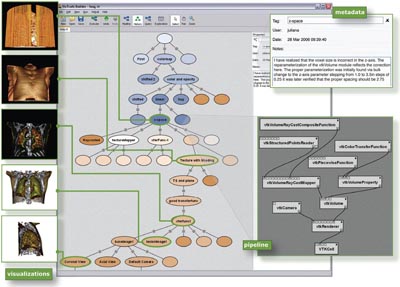 Fig 1: The VisTrails history tree contains a node for each version of a workflow (or pipeline) as it evolves over time. This results in a complete audit trail of the steps that were taken in a computational task. |
Best Paper at Vis 2007
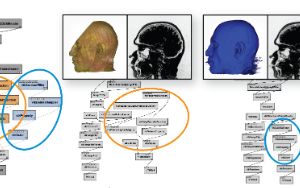 The paper "Querying and Creating Visualizations by Analogy", by Carlos E. Scheidegger, Huy T. Vo, David Koop, Juliana Freire, and Cláudio Silva was selected as the "Best Paper" at IEEE Visualization 2007. In this paper, the authors introduce a new framework that allows users who are not necessarily programmers to query and refine pipelines (or workflows) by analogy. They describe a query-by-example interface which allows users to construct as complex, structure-based queries (e.g., find workflows that resample a data set before extracting an isurface) by example, using the same interface used to build pipelines. They also introduce analogy as a first-class operation to create and refine pipelines. The analogy operation allows casual users to modify pipelines without having to directly edit their definitions. These features have been implemented in their open-source workflow and provenance management system called VisTrails, which can be downloaded from the SCI Website.
The paper "Querying and Creating Visualizations by Analogy", by Carlos E. Scheidegger, Huy T. Vo, David Koop, Juliana Freire, and Cláudio Silva was selected as the "Best Paper" at IEEE Visualization 2007. In this paper, the authors introduce a new framework that allows users who are not necessarily programmers to query and refine pipelines (or workflows) by analogy. They describe a query-by-example interface which allows users to construct as complex, structure-based queries (e.g., find workflows that resample a data set before extracting an isurface) by example, using the same interface used to build pipelines. They also introduce analogy as a first-class operation to create and refine pipelines. The analogy operation allows casual users to modify pipelines without having to directly edit their definitions. These features have been implemented in their open-source workflow and provenance management system called VisTrails, which can be downloaded from the SCI Website.




